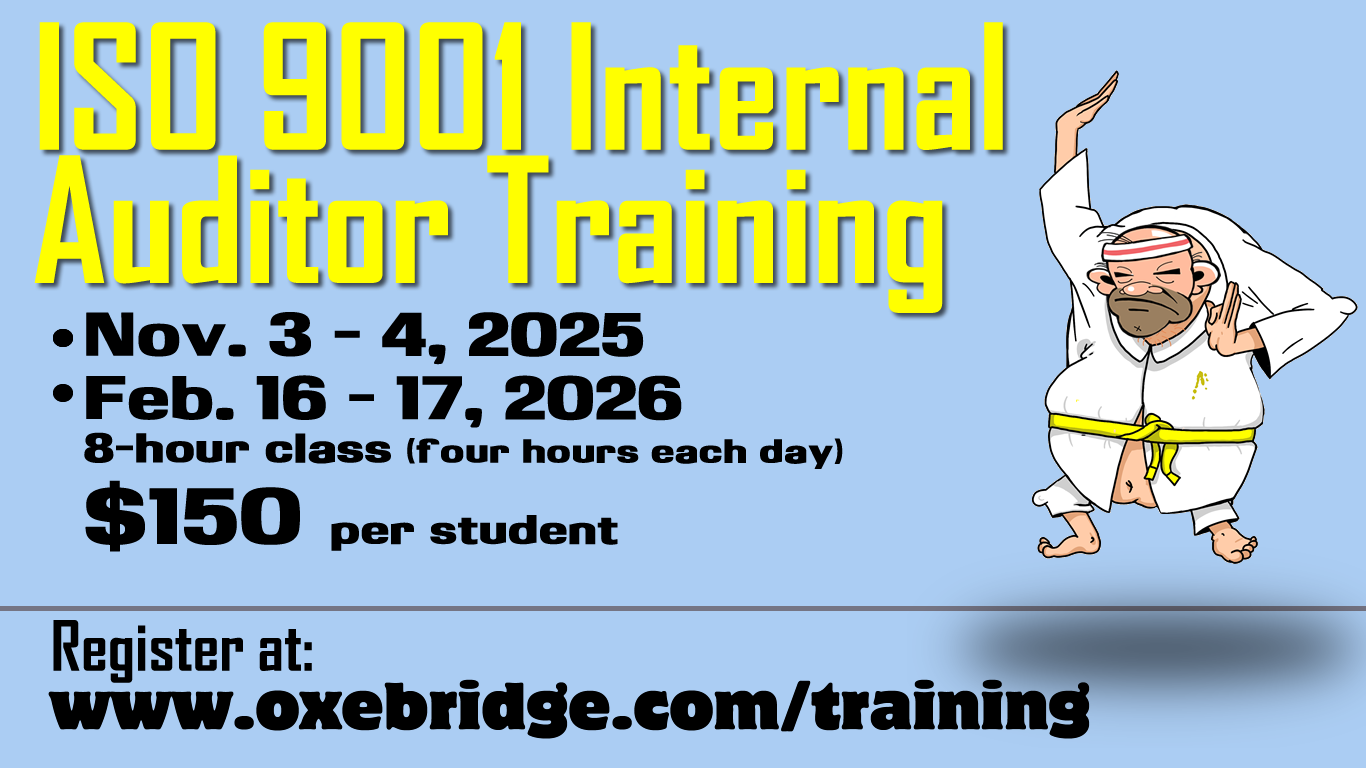 I don’t want to belabor the debate beyond its usefulness, and I maintain that my Public Call for Temporary Cessation in the Development of ISO 9001:2015 remains valid as-is, but ISO TC 176 Chair Dr. Gary Cort has taken the time to distribute a response, and some of the statements made in that response require clarification.
I don’t want to belabor the debate beyond its usefulness, and I maintain that my Public Call for Temporary Cessation in the Development of ISO 9001:2015 remains valid as-is, but ISO TC 176 Chair Dr. Gary Cort has taken the time to distribute a response, and some of the statements made in that response require clarification.
Endorsement
Dr. Cort indicates that I implied an endorsement of the Public Call document in my cover letter. This is not true. The bulk of the distributions included no reference to Dr. Cort at all. A small number (less than 10) of initial emails went out with the sentence, “The document has been received with interest by Dr. Gary Cort, as well as key representatives of the automotive and aerospace industries.” This is factually true, as Dr. Cort requested an advance copy for him to “distribute.” Specifically, on April 24th he wrote:
Thanks for sharing this with me. I will be happy to discuss it with you. Do you object if I share it with others or would you prefer that the only distribution be through you? Best regards, –GC
The phrase “received with interest” is therefore factually correct. In other emails I made it plain that this did not amount to an endorsement, writing that, ” That should not be read as an endorsement, however.” It is likely that Dr. Cort is referring to an earlier email, but at no time was a statement made that he endorsed the document, because it was never likely that he would. It was always expected to play out exactly as it has.
Quality Management Principles
The points made regarding Quality Management Principles are supported by the published agenda (still available here) of the St. Petersburg meeting, released by ISO itself, and then corroborated by statements given to me by actual participants. There is no disputing the fact that the QMPs are not finalized, and yet the ISO 9001:2015 is hurdling towards Committee Draft (CD). Dr. Cort may consider the remaining work “editorial” in nature, but regardless, the QMPs are not fully developed to the point where they can act as the framework for the ISO 9001:2015 standard in the way they are intended. So, once again, the Oxebridge document is factually true.
(UPDATE: See more on this: Official ISO Documents Contradict TC 176 Statement re: Quality Management Principles.)
China
Dr. Cort challenges the ISO Survey data, but does not address the overwhelming number of nations that are facing falling certificate totals. Instead, he focuses on the data presented on China.
The Public Call document highlights China because it is — for now, at least — used by ISO and its spokepersons as the talking point to defend falling certificate numbers nearly everywhere else. I have written elsewhere on how this is not technically true. The chart that Dr. Cort has specific problem with shows that China’s growth rate has not only fallen (by his own admission, since 1997) but flatlined. Dr. Cort is satisfied with the flatline. In fact, he is satisfied enough with a flatlined statistic from a single country to ignore entirely the rest of the world’s data, as well as the flood of criticism the TC has faced from multiple parties across the world.
A sustained growth of 100% per year is impressive. But focusing only on a single statistic creates a number of problems for ISO. First, it skews ISO 9001’s targeted audience to a single nation – China – at the expense of every other country on the planet, and justifies the current practice of ignoring the input of major world industries such as automotive and aerospace, which have considered “decoupling” form ISO entirely (a point Dr. Cort chooses not to address at all.) ISO is not the People’s Republic of China Organization for Standardization; it is international.
Secondly, relying on a single nation as justification can backfire. The Russian Federation had similar 100%+ growth rates nearly every year since 1994, until it was discovered that 80% of the certificates were unaccredited and the numbers had to be corrected for the 2011 ISO Survey. Reports of massive certificate fraud in China continue to plague the nation, so relying on China’s raw growth totals is likely to be problematic in the future. (Expect an equally embarrassing data correction or – as I suspect will happen – ISO to abandon publishing The Survey entirely.)
Dr. Cort also fails to compare the Chinese certificate totals against any other data point, allowing it to hang in space while nevertheless claiming that “any purveyor of a mature product, regardless of market or industry, would consider [the China growth rate] wildly successful.” Unfortunately for Dr. Cort, any such purveyor would not merely look at a single statistic, but instead compare that number to the actual size of the target market. According to Chinese news service Xinhau, China has 40.6 million private businesses alone. The government does not release data on the number of state-run enterprises, but to suggest this number is in the hundreds of millions would not be exaggeration. But even if we focus only on private enterprise, then after after more than two decades ISO 9001 has only penetrated 0.8% of the potential market. Factor in the state-run enterprises, schools, defense and myriad other potential users of ISO 9001, and you see how anemic the China data really is.
Dr. Cort’s labeling of ISO 9001 as a “mature product” mirrors the outlandish statement made by current ISO Secretary General Rob Steele who explained away the hemorrhaging of ISO certificates in markets such as Europe, North America and parts of Asia by saying, “A number of markets where certification took off in the early 1990s are showing signs of having reached maturity.” By parroting this talking point, Dr. Cort and Secretary Steele effectively broadcast to the world that ISO 9001 has an expiration date, that it sours over time like curdled milk. It tells its potential users that after a period of time, abandoning the product is expected. This is astounding in its shortsightedness, and more damning than anything that could be stated by ISO 9001’s most vehement critics. Certification and accreditation bodies should be frothing at the mouth over these statements, as it tells their customers to quit and go home.
ISO 9001 is not, by any metric, “mature.” It is ever changing, always new, and has likely not surpassed a single percentage point in any economy in which it exists.
Established Procedures
In keeping with ISO’s talking points, Dr. Cort indicates that serious consideration can only be given to concerns raised through official channels, using “established processes.” This is not only a convenient tool to avoid addressing critics — something which clearly failed in this case, since Dr. Cort was effectively forced to reply to Oxebridge given the groundswell of support the Public Call has gotten — but it’s also disingenuous.
There is no law, no rule, no restriction on anyone writing to anyone. ISO is not a special organization that cannot be approached without advance permission. ISO is not the Pope. To suggest that communication outside of the established procedures “disrupts development” and “subverts this process” is outrageous, and indicative of the very core of ISO’s problem. ISO and TC 176 truly think they are unanswerable to anyone, and that stakeholders have no place.
And, of course, the Public Call document is being sent to every TC 176 Member Nation, asking them to submit it through their official channels. So it is not yet a done deal that the Public Call will not be submitted by one or more nation, through their national representative. There are no rules that say a document written in one country cannot be sponsored by a member body of another nation.
The reliance on “official channels” is also deceptive. My official channel — ANSI’s US TAG — has refused to respond to the Public Call. They refused to act on data presented to it nearly 10 years ago. They routinely fail to follow their own procedures, holding meetings without a quorum, rigging elections with secret “nominating committees” that offer only single hand-picked candidates, and refuse to ensure a balance of participants across various stakeholder groups, instead endorsing a membership comprised of a majority of consultants. Alka Jarvis and the US TAG leadership have failed to address the concerns of major stakeholders, such as the US aerospace and automotive industries, to the point they have considered abandoning ISO entirely. If the massive United States automotive industry cannot get its concerns carried to Geneva, then the official channels are effectively broken.
(UPDATE: See more on this: Has TC 176 Violated its Own Procedures on 9001 Development?)
Consensus
Likewise, ISO’s claim to rely on “the established ISO processes” to conduct standards development are ironic. In order to meet its target publication date, TC 176 has abandoned procedure — to the extent that they are now violating it — and initiated a “fast track” procedure to release the Committee Draft, using a “small select group” of individuals to write the CD. According to one member of TC 176, who is troubled by this development:
As far as the ‘select group’ – that was not done to any procedure that I’m aware of, which raises some questions, but the whole WG saw the ‘interim’ WD2, and almost 250 comments were submitted. Generally speaking, the editorial comments have been addressed and the technical comments have been put off to the plenary meeting in November, when all the CD comments will be discussed. Strictly speaking, they didn’t follow documented procedures, in this ‘fast track’ procedure, to get from WD1 to CD, and it violates a basic quality concept, by putting speed ahead of quality.
So, to be clear, when faced with a printer’s deadline, TC 176 has no problem violating what Dr. Cort calls “ISO ideals of democratic, consensus-based standards development” in favor of “fast track” development by a handful of handpicked individuals from select nations, alienating the bulk of nations and ignoring the feedback of the WD nearly entirely. So to refuse to consider a request for a simple pause — not the most damaging thing in any context — ISO would rather invoke procedures that it, itself, doesn’t adhere to.
In the end, the Oxebridge Public Call document remains factually accurate, and will be a marker in time for future stakeholders to look back on. ISO was given an opportunity to correct its course, and under the leadership of Dr. Cort, they have elected not to, and to pursue a course that is alienating entire industries and world economies.
That is, unless, lightning strikes twice and a member nation formally requests — through official channels — that a temporary pause be initiated.
The Public Call can be downloaded here, and distributed freely:
Christopher Paris is the founder and VP Operations of Oxebridge. He has over 35 years’ experience implementing ISO 9001 and AS9100 systems, and helps establish certification and accreditation bodies with the ISO 17000 series. He is a vocal advocate for the development and use of standards from the point of view of actual users. He is the writer and artist of THE AUDITOR comic strip, and is currently writing the DR. CUBA pulp novel series. Visit www.drcuba.world








